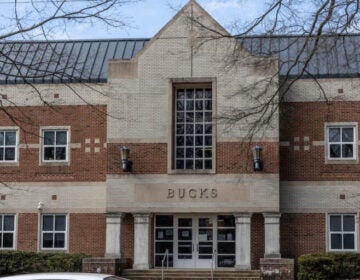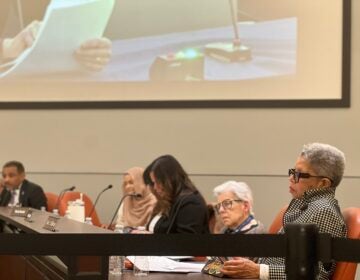When school feels ‘chaotic’: Philly parents struggle with shifting virtual learning guidelines
Even as Philly officials vow to reduce omicron’s interruptions to in-person learning, the school district’s shifts to virtual are causing angst.
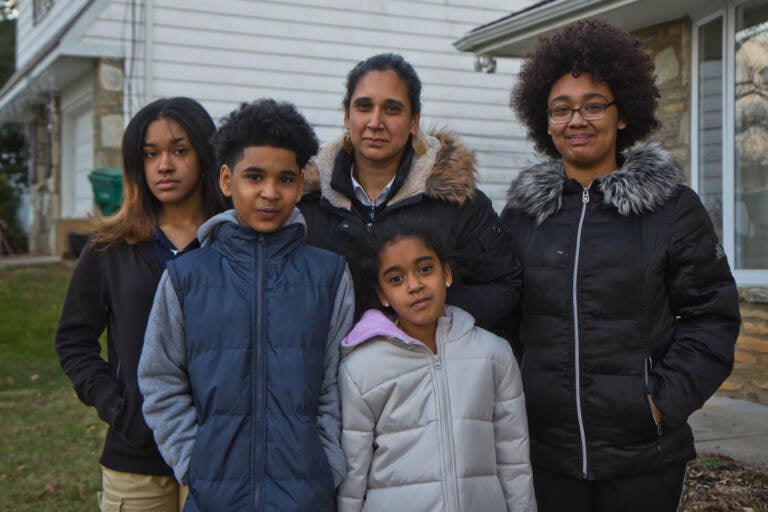
Amina Malik (center), with her children (from left) Rabiyyah, 13, Sadat, 10, Raina, 8, and Ruqayyah, 18, in their yard in Northeast Philadelphia. (Kimberly Paynter/WHYY)
Even as city officials vow to reduce omicron-related interruptions to in-person learning, the Philadelphia School District’s rotating roster of virtual classrooms is causing angst and consternation for many families.
Some parents are struggling to keep up with work obligations while supervising their children, while others want the district to go completely remote as the omicron variant sweeps through the city, infecting teachers and other school staffers.
Superintendent William Hite put 15 schools on remote learning starting Monday, down from more than 100 at the end of last week. The number could increase again in the coming days. The teachers and principals unions continue to demand that the district go all virtual, provide medical-grade masks for students and staff, improve access to testing, and take other safety measures.
“We call on Dr. Hite to honor an adequate safety plan in response to schools that are missing 30-plus staff members on a daily basis, leaving our students without teachers, nurses, support staff, and climate management, and putting them at risk for so many different setbacks,” said Angela Cychowski, a teacher at George Washington High School, in a video posted online Monday by the Philadelphia Federation of Teachers.
Remote learning has led to chaotic scenes at Amina Malik’s home in University City, where three of her children are learning virtually and the fourth, her oldest, is staying home to watch the others while accumulating absences along the way.
Malik’s husband passed away last year. Her mother often watches the kids at her house in Northeast Philadelphia, but after the three youngest tested positive for COVID-19 earlier this month, Malik kept them home rather than risk infecting their grandmother.
When she had to go to her job as a high school teacher in Delaware County last week, the kids were on their own at home. On top of that, a contractor unexpectedly came by to complete some work on their house, putting those rooms off-limits to the children.
“Everybody’s in two rooms. One’s yelling at their teachers, the other one’s trying to talk — it’s just a little chaotic,” Malik said Friday, during a break from work. Her oldest daughter had called and said the youngest, a second grader, was struggling with virtual school. “She’s like, ‘Raina is acting up, she won’t listen, she’s jumping around.’ For the younger ones, virtual, it’s harder for them.”
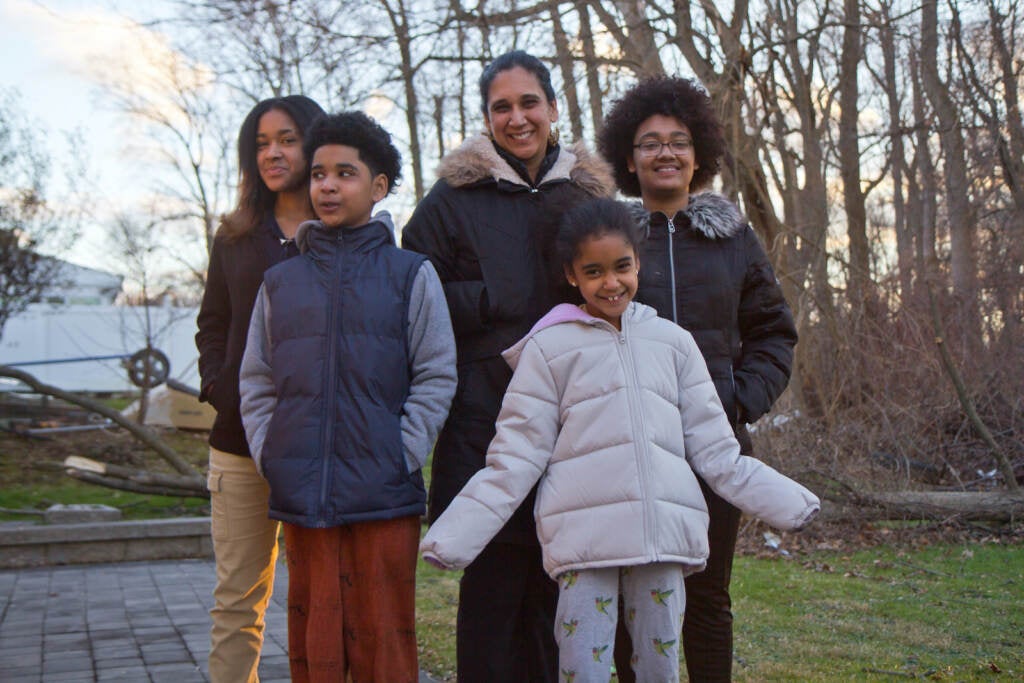
Despite her family’s struggles, she was in no hurry to see her kids return to in-person learning. While Philadelphia Health Commissioner Dr. Cheryl Bettigole has said COVID transmission rates are low in schools, Malik said the risk still makes her uncomfortable.
“The school district of Philadelphia is doing a disservice to all the children in our community. Everybody should be home. I feel like the numbers are going to keep going up. I want all of them to be virtual, I really do. I don’t feel safe with my kids being in school,” she said. “They say if you’ve gotten this variant, then you won’t get it again. But who’s to say there’s not another variant in two days?”
School officials say kids are better off on campuses
District officials say they remain committed to keeping kids on campuses as much as possible. They cite recommendations from the Centers for Disease Control, Bettigole, and the Children’s Hospital of Philadelphia’s PolicyLab research group, who say the risk of infection is outweighed by the benefits of in-person schooling.
“We absolutely understand that people have concerns. However, the science shows that if the proper mitigation efforts are put into place, then the likelihood of contracting COVID or passing it on is very low,” district spokeswoman Monica Lewis said in an interview. “We all know that the best place for our children to be is in a school building with their teacher and their peers, and that’s what we are committed to doing.”
Fear of COVID nonetheless remains a major motivating factor for some parents. Since winter break, Stefanie Marrero of Southwest Philadelphia has kept her three youngest children, a second grader and two fourth graders, home from Richmond Elementary. Only her 10th grader attends school, at Kensington Creative & Performing Arts High School, where Marrero said few students have tested positive for infection.
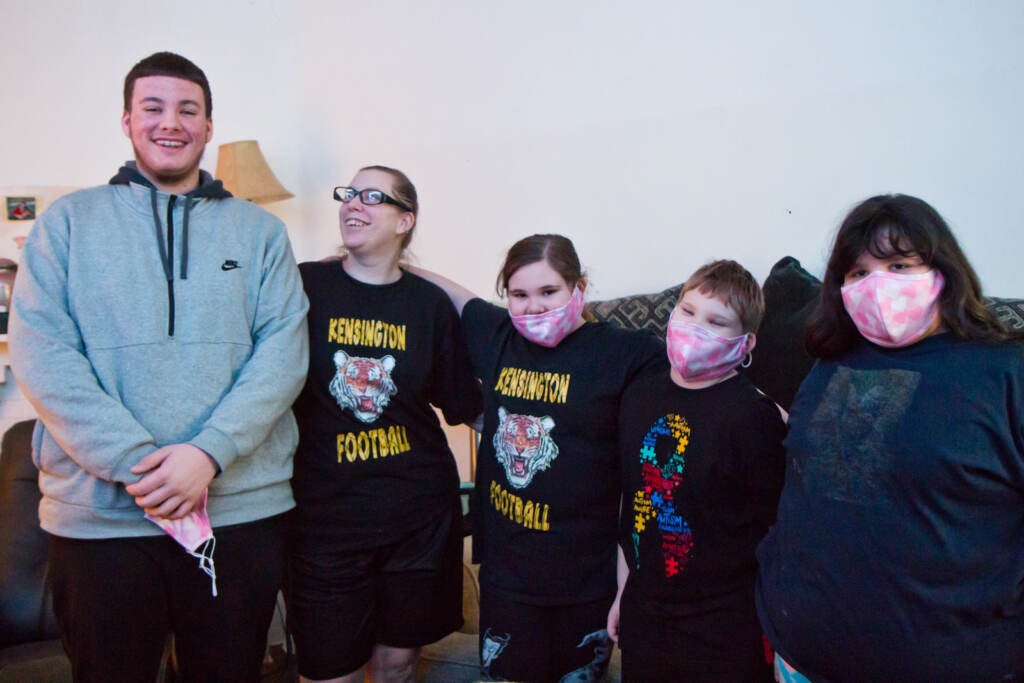
When a school is open for in-person instruction, the district will not provide remote lessons to the students unless they’re quarantining after a positive COVID test. So Marrero’s three children aren’t learning and they’re being marked absent every day. But she said she’s an amputee and has heart and lung conditions, and she can’t risk having them bring home an omicron infection.
“My children basically are sitting at home, on their phones, on PlayStation, not doing anything with their time, because the teachers aren’t assigning anything. I feel like, if the children that are going in person are doing the same lessons in class, why can’t you take five minutes and assign it to the children that are actually home?” she said.
Marrero said she wants to see the district temporarily go all-virtual while it institutes a rigorous testing system to ensure that infected students stay home from school and prevent further disease spread.
“That’s the only way we’re going to make sure our children are testing negative and that they can get the proper education. I’m all for in-person learning by all means, but I want my children to go into clean and safe buildings first. That’s key,” she said.
Marrero also faulted the district and the health department for setting a higher threshold for the positive testing rate that triggers a shift to virtual learning.
Case counts no longer a deciding factor in closures
While schools often go virtual because of staff shortages, in the first week of January the city announced that a school will also close when 10% of its staff and students test positive, up from 3% before. On Wednesday, Bettigole ended that policy entirely, saying case counts will no longer be used because COVID-19 is so widespread.
The criteria for keeping some schools open and closing others was also unclear to parent Shereda Cromwell. Given the mass teacher absences, many students were not even getting the benefits of in-person learning that were driving the district’s policy, she said.
Her two older children, who are autistic, attend a charter school that had been virtual since mid-December. But her 10th grader, Aidan, attends Franklin Learning Center, which resumed in-person instruction last week after a week of virtual teaching.
“Monday, when my son came home, he informed me that there were 22 teachers out. They spent the whole day in the auditorium. It was very chaotic, and there was little to no learning going on,” Cromwell said Friday. “I sent an email to the principal. I wanted to know, when there were already 91 schools going virtual, why would this school still be open?”
“You say we’ve got to get them in the building because they learn more when they’re in the building, but there was no real learning going on. So you’re potentially risking having my son exposed to COVID for no particular reason at all,” she said. “I know the school district is trying to find strategies that work. But certain things just don’t make sense to me.”
She decided to keep Aidan home for the rest of last week, even though she knew that meant he would not be doing any learning at all and would be marked absent.
Cromwell herself works at a charter school, and while her schedule allows her to be home much of the week, she says she understands the struggles of other working parents. As part of her job she sometimes calls parents whose children are not logged into virtual school, and has heard them explain that they cannot be home to supervise their kids.
But she still wants to see Hite at least temporarily return to the district-wide virtual learning model that was in place for most of the previous school year. While that would be challenging for some families, it would at least represent a clear policy that everyone is already very familiar with, she said.
“I just can’t take the inconsistency. I’m checking my phone every two hours to see if I got a text message or to see if I got an email about, did his school finally close. And that’s creating a level of stress in my life,” Cromwell said.
“Let’s try to create as much consistency as possible for the families,” she said. “I do know that everyone did it for a year. If we had to figure it out again, for two months or two weeks, just to kind of ensure that our babies are safe, then I think that’s the most important thing.”
 WHYY is one of over 20 news organizations producing Broke in Philly, a collaborative reporting project on solutions to poverty and the city’s push towards economic justice. Follow us at @BrokeInPhilly.
WHYY is one of over 20 news organizations producing Broke in Philly, a collaborative reporting project on solutions to poverty and the city’s push towards economic justice. Follow us at @BrokeInPhilly. 
Get daily updates from WHYY News!
WHYY is your source for fact-based, in-depth journalism and information. As a nonprofit organization, we rely on financial support from readers like you. Please give today.
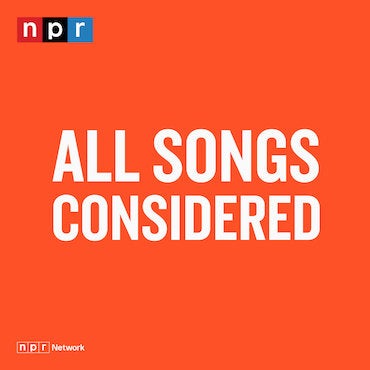



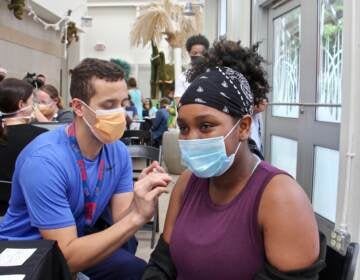
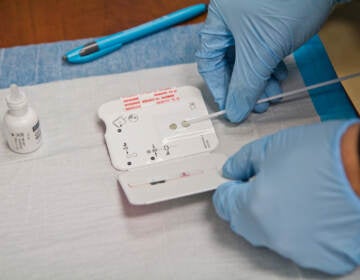
![CoronavirusPandemic_1024x512[1]](https://whyy.org/wp-content/uploads/2020/03/CoronavirusPandemic_1024x5121-300x150.jpg)

